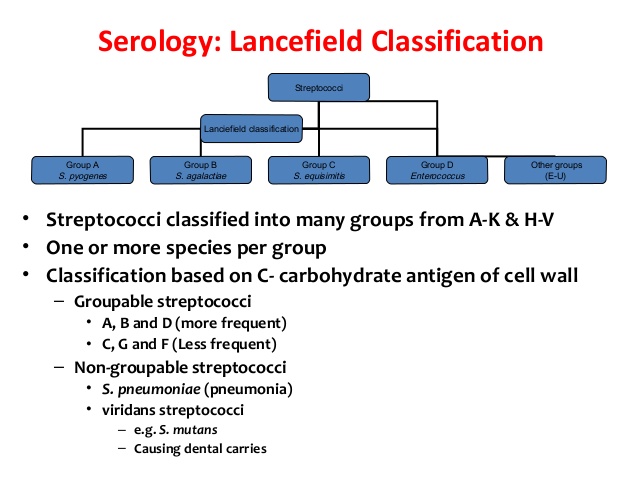
- The genus Streptococcus includes a large number of species of Gram-positive, catalase negative cocci.
- They are non-motile and non-spore forming.
- They are arranged in chains of varying length and also in pairs.
- Some of them form the normal flora of man and animals while some like Streptococcus pyogenes are human pathogens.
- There are different bases of classification of Streptococci:
1. On the basis of Oxygen requirement:
- Aerobes and facultative anaerobes: E. g. Streptococcus spp
- Strict or obligate anaerobes: E. g. Peptostreptococcus
2. Brown’s classification (On the basis of haemolytic pattern on blood agar):
- Aerobic and facultative anaerobic Streptococci are further classified on the basis of haemolytic property or pattern on blood agar.
- It was described by J.H. Brown in 1919.
- On this basis, there are three groups of Streptococci.
- Alpha-hemolytic Streptococci:
- Exhibit incomplete hemolysis (1-2mm wide)
- Impart a greenish discoloration around the colony with few persistent unhemolyzed RBCs
- e.g. Viridians streptococci, Streptococcus pneumoniae
- Beta-hemolytic Streptococci:
- Exhibit a wide zone of complete hemolysis (2-4 mm wide)
- Account for majority of Streptococcal diseases
- e.g. Streptococcus pyogenes
- Non-hemolytic Streptococci:
- Also called gamma-hemolytic Streptococci
- Don’t cause hemolysis at all
- Usually non pathogenic
- e.g. Streptococcus faecalis which are now grouped under a new genus Enterococcus.
- Alpha-hemolytic Streptococci:
3. Lancifield classification or serological classification:
- Also known as serological grouping, it was put forward by Rebecca Lancefield in 1933.
- Most strains of beta-hemolytic and some of alpha-hemolytic and non-hemolytic Streptococci are classified on this basis.
- It is based on the difference of group specific polysaccharide antigen on the cell wall of Streptococci.
- Streptococci are classified into 20 Lancifield groups from A to V (except I and J).
- Group A: Streptococcus pyogenes
- Group A streptococci i.e. pyogenes are further sub divided into approximately 80 serotypes by Griffith according to their specific surface proteins (M, T and R). M-protein is the most important one.
- The pathogenicity of Streptococci depends on the presence of hyaluronic acid capsule and surface M-protein.
- Group B: Streptococcus agalactiae
- Group C: Streptoccus equi
- Group D: Enterococcus
- Others (group E to V)
- Group A: Streptococcus pyogenes
4. On the basis of 16s rRNA sequence:
- The genus Streptococcus is further subdivided into six clusters on the basis of comparative analysis of 16s rRNA sequences.
- Pyogenic group:
- Consists of predominantly beta-hemolytic species that are pathogenic in humans or animal species.
- e.g. Streptococcus pyogenes, S. agalactiae
- Anginosus group:
- Found in the human oral cavity, gastrointestinal tract and genital tracts as normal flora
- Sometimes isolated from infections
- e.g. Streptococcus anginosus, S. intermedius
- Mitis group:
- Includes several oral streptococci
- e.g. Streptococcus mitis, S. pneumoniae
- Salivarius group:
- Consists of both dairy streptococci and species found in the human oral cavity
- e.g. Streptococcus salivarious, S. thermophiles
- Bovis group:
- Inhabits the intestinal tract of several animals species and sometimes humans
- e.g. Streptococcus bovis, S. equines
- Mutans group:
- Mainly colonize tooth surfaces of humans and a number of animal species.
- e.g. Streptococcus mutans, S. ferus
- Pyogenic group:
5. Shermann’s Divisions (On the basis of physiological characteristics):
- It was proposed by Sherman in 1937.
- On the basis of hemolytic reaction, group carbohydrate antigens, and phenotypic tests (primarily fermentation and tolerance tests), he organized streptococci into the following four divisions:
- Pyogenic division:
- Included beta-hemolytic strains with defined group antigens (A, B, C, E, F, and G).
- This division of the streptococci is similar to that of today’s identification systems based on serological classification.
- e.g. Streptococcus pyogenes
- Viridans division:
- Included streptococcal species that were neither beta-hemolytic nor were tolerant to high-pH growth conditions.
- They couldn’t tolerate salt, and did not grow at 10°C.
- Most of them are normal flora of upper respiratory tract of humans.
- Lactic division:
- Included strains used in manufacture of dairy products.
- Not associated with human infections
- Reclassified as the genus, Lactococcus in the mid-1980s.
- They are non-hemolytic groups.
- e.g. Lactococcus
- Enterococci division:
- Can grow in broths at high pH and can tolerate high salt concentrations
- Has a wide temperature range (10 to 45°C) for growth
- They are the normal flora of human intestine
- e.g. Enterococcus
- Pyogenic division:

